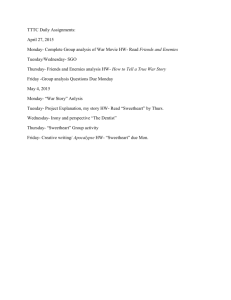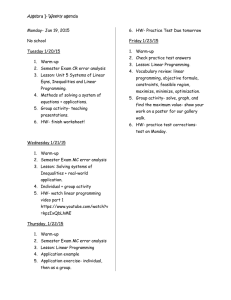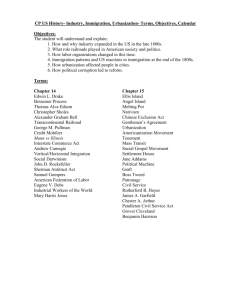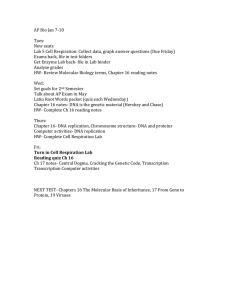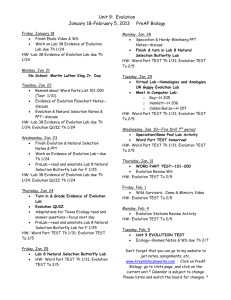! "#$%&'()!#*+$,#'*+! "-.!/011.234!56!2-.!781.!"95:3;81!#.<509;.<!&4<23202.!
advertisement
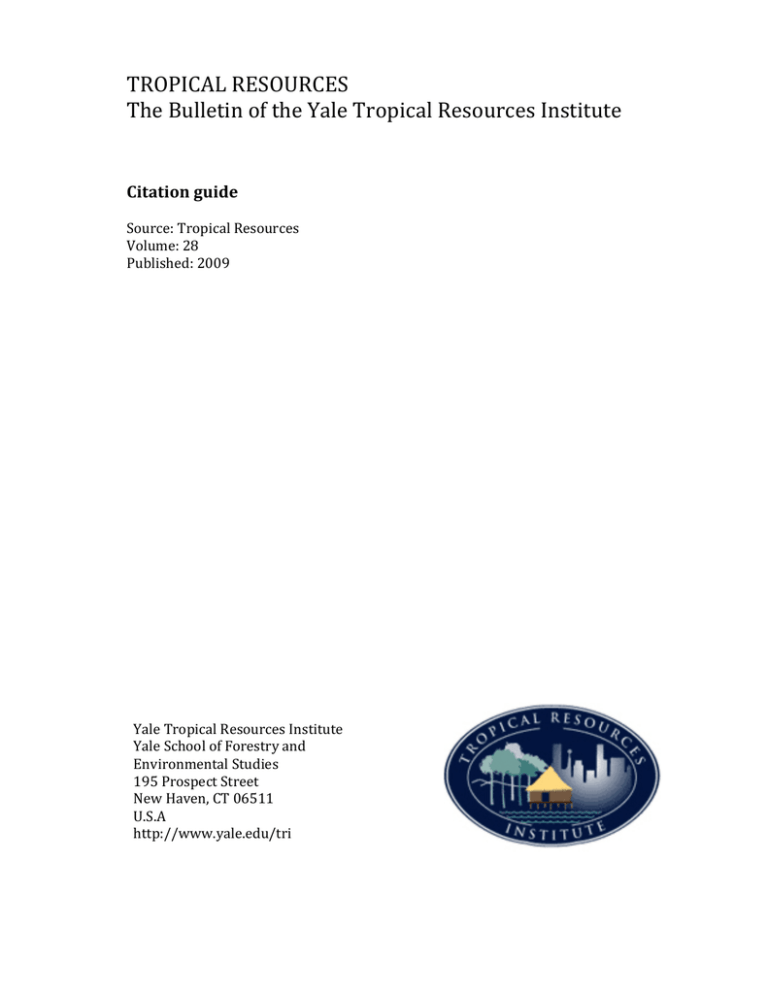
! ! "#$%&'()!#*+$,#'*+! "-.!/011.234!56!2-.!781.!"95:3;81!#.<509;.<!&4<23202.! ! ! ! ! "#$%$#&'!()#*+! ! +509;.L!"95:3;81!#.<509;.<! N510A.L!OP! %0Q13<-.?L!OIIC! ! ! ! ! ! ! ! ! ! 781.!"95:3;81!#.<509;.<!&4<23202.! 781.!+;-551!56!=59.<29>!84?!! *4@3954A.4281!+20?3.<! BCD!%95<:.;2!+29..2! E.F!G8@.4H!'"!IJDBB! ,K+K(! -22:LMMFFFK>81.K.?0M293!! ! ! ! ! ! ! ! ! Improving Brazilian Land Use Law: A Case Study of Plantation Forestry in Southern São Paulo Christopher Finney, MEM 2009 Years before this study began, I was an environmental educator a few miles north of the study area. My daily commute involved crossing a stream that was so laden with human waste from nearby slum settlements that the stream bubbled with TL[OHUL·HUK[OPZZ[YLHTÅV^LKZ[YHPNO[PU[V[OL T\UPJPWHS^H[LYZ\WWS`3VJHSRUV^SLKNLOVSKZ[OH[ the slums were the direct result of overly–restrictive aVUPUNSH^ZPU[LUKLK[VWYV[LJ[[OL^H[LYZOLKPU[OL Z;OLZLSH^ZWYVOPIP[LKLZZLU[PHSS`HSSWYVK\Jtive uses, eliminating any economic incentive for landowners to manage their property. After private owners lost interest in their land, the slum settleTLU[Z[VVRV]LY)LJH\ZL[OLZS\TZ^LYLPSSLNHSMYVT the beginning, no sewer lines or other infrastructure was ever installed. The desire to protect the watershed thus resulted in unintended human and environmental consequences, demonstrating the need to integrate both economic and environmental perspectives in solving many of São Paulo’s most pressing problems. Sustainable forestry offers one such solution. Local law however must be carefully formulated to support sustainable forestry within the context of regulating land use. This case study directly addresses the regulatory issues that must be addressed in southern São Paulo. I hope it also sheds useful light on the myriad other situations in which environmental and economic issues require integrated, pragmatic solutions. Background :qV7H\SV)YHaPSPZ[OL^VYSK»Z[OPYKTVZ[ WVW\SV\ZJP[`^P[OV]LYTPSSPVUYLZPKLU[Z;VYYLZ et al., 2005), and southern São Paulo in particular experiences population growth in excess of 8% per year (Tesch, 2008). The area of study, the Capivarí– Monos Environmental Protection Area, occupies the southernmost 25,000 ha of the city. This area is an important source of ecosystem services; its watershed provides approximately 24% of the city’s potable water, as well as wildlife habitat, carbon seX\LZ[YH[PVUHUKZVPSWYV[LJ[PVU)YHNHL[HS Geographically, the study area provides a buffer IL[^LLU:qV7H\SVHUK[OL:LYYHKV4HY:[H[L7HYR the largest legally protected tract of Atlantic Forest, a global biodiversity hotspot (Meyers et al., 2000). ;OL*HWP]HYx¶4VUVZPZJSHZZPÄLKHZHU,U]Pronmental Protection Area (APA), a participatory NV]LYUHUJLZ`Z[LTPU^OPJOT\UPJPWHSVMÄJPHSZHUK local representatives share authority for land use regulation. Land uses in the study area include small farms, native secondary forest, native primary cloud forest, natural grasslands, and active and abandoned commercial plantations of pines (Pinus spp.) and eucaplypts (Eucalyptus spp.). By focusing on the regulations governing plantation forestry in the Capivarí–Monos, this article explores the use of the term “sustainability” as a leNHS[LZ[PU)YHaPSPHULU]PYVUTLU[HSSLNPZSH[PVU>OPSL the area is subject to unusually restrictive environmental legislation, this study shows that “sustainabilP[`¹KVLZUV[HKLX\H[LS`N\PKLSHUK\ZLJSHZZPÄJHtion, and proposes that standards from independent JLY[PÄJH[PVUVYNHUPaH[PVUZILHKVW[LKPUZ[LHK Sustainability in Brazilian Environmental Law )YHaPSPHULU]PYVUTLU[HSSH^MYLX\LU[S`\ZLZ sustainability as a legal test to determine whether a given land use is permitted. In the study area, the TVZ[YLZ[YPJ[P]LSHUK\ZLYLN\SH[PVUZHYLKLÄULKPU [LYTZVMZ\Z[HPUHIPSP[`HUKHYLHWWSPLK[VaVULZPU the study area that contain a large proportion of São Paulo’s natural land cover and commercial planta[PVUMVYLZ[Y`-PN\YLZHUK 0U[OL*HWP]HYx¶4VUVZ[^VaVULZHYLVMWHYticular importance and cover a majority of the area. The Wildlife Zone (ZVS)2PZKLÄULKHZ¸WVY[PVUZVM the municipal territory of great importance for the protection of hydrological resources and biodiversity, Z\JOHZHSS\]PHSWSHULZZPNUPÄJHU[YLTHPUPUNWH[JOLZ of Atlantic Forest herein delimited, as well Tropical Resources Bulletin 31 Christopher Finney Law or Legal System Purposes Use of "sustainability" as a legal test National System of Conservation Units (Federal Law 9,985/2000) orders types of natural preserves (including APA and State Park, below) • Establishes criteria and norms for the creation, implementation and management of Conservation Units. • Objective IV: "encourage natural resourcebased sustainable development" • Defines sustainable use as: "use of the environment such that the permanence of renewable environmental resources and ecological processes is assured, maintaining biodiversity and other ecological attributes, in a socially and economically viable manner. • Several types of Conservation Units are defined in terms of sustainability: Nationalforest: "basic objective is multiple sustainable use offorest resources and scientific research, with an emphasis on methods for the sustainable use of native forests." Extractivist Reserve: "commercial use of timber resources is permitted only on a sustainable basis" Wildlife Reserve: appropriate for scientific research on "sustainable economic management of faunal resources" Sustainable Development Reserve: home to local peoples "whose liveliboods are based on sustainable systems of natural resource use" Biosphere Reserve: an international model for "integrated, participatory, sustainable management of natural resources" "Law of the Atlantic Forest" (Federal Law 11,438/2006) 'The general objective of the protection and use of the Atlantic Forest Biome is sustainable development, the specific objectives are protection of biodiversity, human health, landscape, aesthetic and tourism values, the hydric regime, and social stability." • Defmes sustainable use as: sustainable agroforestry activities practices on small or rural family landholdings that do not fundamentally change the character of the vegetative cover and do not harm the environmental function of the area • Agencies must "assist traditional populations and small landholders with the sustainable management and use of native plant species." • The government shall "encourage, with economic incentives, the protection and sustainable use of the Atlantic Forest Biome." Serra do Mar State Park (2006) To ensure the full protection of the flora, fauna, and natural beauty. • Buffer zone (APA Capivari-Monos): intended "to create and implement projects and activities that seek sustainable development for the region" - AP A CapivariMonos (Municipal Law 13.136/2001) Encourage the sustained use of natural resources; protect biodiversity; protect hydrological resources and remaining patches of Atlantic Forest, among others • Wildlife Zone and Sustained Use Zone: permits "sustainable agroforestry management activities" • Agricultural Use Zone: "intended to encourage the sustainable development of resident communities in the APA" Municipal Zoning (Municipal Law 13.855/2004) "To encourage regional development based on economic activities that are compatible with the production of water, watershed infiltration areas, and sustainable rural activities; expansion of protected lands ... [and] to ensure water quality and a water supply." • Special Agricultural Protection Zone: permits "sustainable management" without further clarification • Protection and Sustainable Development Zone: permits "uses that are environmentally compatible with sustainable urban development ... sustainable management [among others]." Executive Decree 45.817/ 2005 "To define and detail the classification of given activities within different [zoning] categories of use and groups of activities." "Nonresidential uses compatible with sustainable development" include "sustainable forest management" and "sustainable management activities ... such as agroindustry, agroforestry activities, and agriculture" Directive 0112006 Regulates forestry in the region of study within the above legal regimes "Necessary environmental measures will be determined in order to ensure the retention of cover and sustainability of the property." Figure 1. BraZilian environmental law formulated in terms of sustainability. as the headwaters of waterways of special interest to the water supply." Similarly, the Conservation and Sustained Use of Natural Resources Zone (ZUS)3 is defined as "areas in which the moderate and self-sustaining use of the biota may be permitted, when regulated to ensure that natural ecosystems are maintained." Both zones permit "sustainable agroforestry management activities, duly licensed by the appropriate agencies" (italics added). 32 Volume 28, Spring 2009 The question of what constitutes sustainable agroforestry management is problematic. Applied to forestry, sustainability can be viewed either in a narrow sense, focusing strictly on the ongoing yield of products from a single plot, or broadly, by considering the social, economic and environmental effects locally and at the landscape scale (Evans, 1999). Brazilian law defines sustainability broadly; in the National System of Conservation Units (Federal Law Brazilian Land Use Law in Southern São Paulo APA C a piv a rí-M on o s, I nte rn a l Z o ning B raz il Figure 2. Zoning in the APA Capivarí-Monos. ZRLE refers to a state park, ZVS is a wildlife zone, ZUS is a zone designated for the sustained use of natural resources, and ZEP AG is set aside for special agricultural activities. S ao P au lo ZRL E ZVS ZUS ZEP AG Oth e r 9.985/2000) — which regulates the APA and thus NV]LYUZ[OL*=:HUKA<:·Z\Z[HPUHIPSP[`PZKLÄULK as “use of the environment such that the permanence of renewable environmental resources and ecological processes is assured, maintaining biodiversity and other ecological attributes, in a socially HUKLJVUVTPJHSS`]PHISLTHUULY¹;OPZKLÄUP[PVU fails, however, to provide a meaningful legal test PUKPMMLYLU[PH[PUNIL[^LLU[OLÄULI\[ZPNUPÄJHU[ gradations within land uses such as plantation forestry. The following examinations of “industrial” forestry (intensively–managed exotic monocultures) and “native” forestry (commercial plantation forestry using native timber species, sometimes incorporating mixed species designs) illustrate this problem. Overall sustainability of forestry >VYRPUN^P[OHUHYYV^KLÄUP[PVUVMZ\Z[HPUability, which considers only the permanence of timber productivity on a given piece of land, most forestry can be considered sustainable. Although soil nutrient loss threatens future productivity in some systems, this is often a consequence of management decisions, rather than the intrinsic nature of forestry ,]HUZ /V^L]LY\UKLYHIYVHKKLÄUP[PVU that considers social, economic, and environmental impacts, forestry may or may not be considered Z\Z[HPUHISLKLWLUKPUNVUZWLJPÄJTHUHNLTLU[ decisions. A determination of “sustainability” is further complicated when forestry is compared to other possible land uses; measured in terms of overall environmental services for instance, plantation forestry represents a more sustainable land use than degraded pasture, but a less sustainable land use [OHUTHPU[HPUPUNUH[\YHSMVYLZ[,]HUZ With proper management, plantation forestry can have several positive effects. First, it can provide ecosystem services by enhancing watershed function and biodiversity (Montagnini, in press). Second, forestry provides economic returns, increasing property values and counteracting the trend toward subdiviZPVUHUKVJJ\WH[PVUVMSHUKWYV]PKPUNHRL`HYN\ment for the retention of this land use in southern São Paulo. Third, managed forestry reduces pressure on native forests by producing timber at higher rates than do natural forests, although complete product Z\IZ[P[\[PVUPZ\USPRLS`:LKQVHUK)V[RPU " 6SP]LYHUK4LZaUPR3HZ[MVYLZ[Y`JHUWYV]PKLHI\MMLYaVULMVYWYV[LJ[LKSHUKZ[O\ZYLK\JPUN anthropogenic and physical edge effects (Ries et al., 2004). Industrial plantation forestry Heavily–managed monocultures of exotic species represent one extreme of a spectrum of plantation strategies. Pine and eucalypt plantations are present in the study area and much of tropical Latin America. Both species, however, interfere with the biodiversity of native land cover in the Atlantic Forest biome. In the adjacent Serra do Mar State 7HYRWPULZHUKL\JHS`W[ZHYLJVUZPKLYLKPU]HZP]L ZWLJPLZ7,:4WVZPUNHWHY[PJ\SHY[OYLH[[V [OLIPVKP]LYZP[`VMUH[\YHSTVU[HULÄLSKZ4HYZKLU et al. (2004) found only eight species of birds in L\JHS`W[\ZWSHU[H[PVUZSVJH[LK^P[OPURTVM PU[HJ[([SHU[PJ9HPUMVYLZ[JVTWHYLK[VZWLJPLZ encountered in adjacent intact rainforest and 59 species encountered in fragments of native forest. Tropical Resources Bulletin 33 Christopher Finney Eucalypt plantations also threaten watershed function. In southeastern Brazil, the water table fell 2.5 m over the first nine years of a eucalyptus plantation (Soares and Alameida, 2001). In a review of the effects of forestation in the tropics, Scott et aL (2005) report consistent evidence that water use exceeds annual precipitation considerably when eucalypt plantations occur on deep (>8m) soils, particularly in seasonal environments, as well as "overwhelming evidence" of reduced annual surface water yield relative to grassland and scrub in the subhumid tropics, subtropics, and temperate zones. Given that the legal objectives of the APA Capivarf-Monos are to "protect biodiversity; hydric resources, and remaining Atlantic Forest", and considering these plantations have negatively affected these ecosystem functions within and near the study area, they appear incompatible with management goals for the area. Whether they should be permitted by land use regulations should be reviewed. Native plantation forestry and mixed plantations In contrast to industrial plantation forestry, commercial plantation forestry using native species in the neotropics can improve soil nutrient content, provide habitat for birds, insects, and mammal species, increase native seed rain and recruitment, protect soil nutrients, repress invasive grass species, and provide positive financial returns (Montagnini, 2001; Montagnini, in press). The Manequinho Lopez and Cotia nurseries, which are owned by the municipal government of Sao Paulo, grow many species recommended for reforestation in the Atlantic Forest Biome, indicating the potential viability of their use in the study area (Figure 3). Mixed species designs, especially those involving non-timber forest products, can provide additional ecosystem services and reduce landowners' economic risk. In a recent meta-analysis, Piotto (2008) showed that mixed-species systems increase the growth of timber species. Mixed agroforestry systems provide earlier returns on investment by including understory crops such as heart-of-palm (Euterpe edulis) (Montagnini et aL, 1997). Because illegal harvesting has reduced heart-of-palm to a threatened status in the adjacent Serra do Mar State Park, mixed plantation strategies in the study area may provide significant benefits by reducing illegal harvest while increasing seed availability. Further, 34 Volume 28, Spring 2009 Scientific Name Aspidosperma sp. t Astronium sp. t Balfourodendrum riedenalium t Bombaxsp. Cedrela sp. t Cabralea canjerana Caesalpinia echinata t Cordiasp. t Dalbergia nigra * Enterolobium sp. t * Hyeronima alchorenoides Hymenaea sp. t Inga affinis Inga veriscens Nectranda sp. t Platypodium elegans Schizolobium sp. t Tabebuia sp. t May tenus ilicifolia Peltophorum dubium t Bastardiopsis densifIora Parapiptadenia rigida t Anadenantera macroca a Local Name peroba guarita marfim paineira cedro canjerana pau brasil laura jacaranda negra tamboril licurana jatoba inga inga canela jacaranda licurana ipe espinheira santa faveira louro-branco paraguaio angico Figure 3. Native timber species of the Atlantic Rainforest (Barth, in press; Brewer et al., in press). Species currently available at municipal nurseries of Manequinho Lopez or Cotia. * Nitrogen fixing species. * heart-of-palm seeds are an important food source for key seed dispersers such as toucans, which may increase seed dispersal of other native plant species. This dispersal makes heart-of-palm systems catalysts of forest restoration by increasing natural regeneration in nearby degraded areas and within plantations (Parrotta et aI., 1997; Montagnini, in press). This second generation of natural regeneration - facilitated by improved growing conditions and increased seed dispersal - can be retained in the forest understory. Like natural rainforest understory trees, this natural regeneration is "released" when the first generation of plantation trees is harvested, and can be managed as a productive semi-natural forest or conserved for other values. Discussion Brazil is commonly considered to have an exemplary environmental legal regime, which is ineffective primarily because it is unenforced (Laurence et aL, 2001; Soares-Filho et aL, 2006). In the study area, however, the current legal regime is ineffective partially because of language which is too ambiguous to provide guidance regarding land use. Sustainability provides an especially problematic legal test in relation to borderline land uses, such as plantation forestry, which may be either sustainable Brazilian Land Use Law in Southern São Paulo VY\UZ\Z[HPUHISLIHZLKVU[OLKLÄUP[PVUVM[OL[LYT and the management of the forest. In the study area, improving the coherence and enforceability of the legal structure, rather than its restrictiveness and enMVYJLTLU[WLYZLPZRL`[VPTWYV]PUNLU]PYVUTLU[HS governance. This interpretation follows other studies, which concluded that streamlining policy and governance is important to reducing illegal forest activities worldwide (Tacconi et al., 2003). The current regulatory structure requires that sustainability be considered a single variable with only two categories: sustainable and unsustainable. Sustainability, however, is a composite of different environmental services such as habitat value, watershed protection, soil protection, carbon sequestration, seedling recruitment, and cultural values (Figure 4). Each service varies along a continuous NYHKPLU[ILJH\ZLV\[JVTLZKLWLUKVUZWLJPÄJTHUagement decisions, even within a single land use [`WL-\Y[OLYSHUK\ZLZTH`ILYHURLKKPMMLYLU[S` depending on the weight given each environmental ZLY]PJL;OPZTHRLZZPTWSL`LZ¶VY¶UVKL[LYTPUH[PVUZ impossible, reducing the viability of sustainability as a legal test. An approach is needed that bridges the gap between means and ends — one that allows the goal of sustainability to be approximated despite the LS\ZP]LULZZVMHKLÄUP[PVUVMZ\Z[HPUHIPSP[`[OH[TLL[Z the complexities of real world situations. Recommendations .P]LU[OLYLJVNUPaLKPTWVY[HUJLVM[OLZ[\K` area as a source of ecosystem services, and consider- ing the problematic structure of current regulations, [OL*P[`VM:qV7H\SVULLKZNYLH[LYZWLJPÄJP[`PUP[Z regulations on permissible forms of land use. Because numerous management decisions — including choice of species, planting density, use of chemical inputs, thinning regime, understory clearance, rotation length, harvest methods, and treatment of slash — affect the ecosystem services provided by forestry, regulations to address all of these decisions would ILOPNOS`JVTWSL_THRPUN]VS\U[HY`JVTWSPHUJL HUKLUMVYJLTLU[KPMÄJ\S[:\JOYLN\SH[PVU^V\SK also increase plantation costs without providing adKP[PVUHSÄUHUJPHSYL[\YUZ\UKLYTPUPUN[OLLMÄJHJ` of these forests as an economic barrier to human occupation. Rather than create independent forestry regulations, the City of São Paulo should consider incorWVYH[PUNHMVYLZ[JLY[PÄJH[PVUZ`Z[LTZ\JO[OH[VM[OL Forest Stewardship Council) into local legislation for aVULZPU^OPJO[OLZ[H[LKW\YWVZLZVML_PZ[PUNSLNPZSH[PVUHSPNUZ^P[OJLY[PÄJH[PVUYLX\PYLTLU[Z0UV[OLY ^VYKZ:qV7H\SVZOV\SKTHRLV[OLY^PZL]VS\U[HY` Z[HUKHYKZTHUKH[VY`PURL`^H[LYZOLKHYLHZ;OPZ approach is modeled on the increasing incorporation of green building standards (such as Leadership in Energy and Environmental Design — LEED) into municipal law in the United States. Boston, MA, for example requires that certain classes of buildings be 3,,+JLY[PÄHISL:\ZZTHU:\JOHUHWWYVHJO may offer important advantages to the city, certifyPUNVYNHUPaH[PVUHUKSHUKV^ULYZ;OLJP[`^V\SK ILULÄ[ILJH\ZL[OLJLY[PM`PUNVYNHUPaH[PVU^V\SK [HRLYLZWVUZPIPSP[`MVYZP[LPUZWLJ[PVULUOHUJPUN[OL LUMVYJLHIPSP[`VMZ[HUKHYKZHUKWYV]PKPUNRL`O\THU Figure 4. Sustainability of local land uses depicted as a set of different ecosystem services which vary along continuous gradients. Tropical Resources Bulletin 35 Christopher Finney YLZV\YJLZ(KKP[PVUHSS`YLÄULTLU[ZPUILZ[WYHJ[PJLZ are incorporated into municipal law automatically as [OLJLY[PÄJH[PVUZ[HUKHYKPZHTLUKLK;OLJLY[PM`PUN VYNHUPaH[PVU^V\SKILULÄ[MYVTPUJYLHZLKWHY[PJPWHtion, especially in Latin America, where participation is limited because the costs of improved manageTLU[[`WPJHSS`V\[^LPNO[OLÄUHUJPHSILULÄ[ZVM JLY[PÄJH[PVU.\SSPZVU-PUHSS`HS[OV\NO IV[O[YHKP[PVUHSYLN\SH[PVUHUKTHUKH[VY`JLY[PÄJHtion impose regulatory and economic burdens on SHUKV^ULYZTHUKH[VY`JLY[PÄJH[PVUPZWYLMLYHISL ILJH\ZLP[JHUPUJYLHZL[OLTHYRL[]HS\LVM[PTber products, partially or completely offsetting the economic burden of regulation. In environmentally sensitive areas, such as southern São Paulo, which require some form of regulation to protect environmental services, such as habitat and watershed func[PVUTHUKH[VY`JLY[PÄJH[PVUJHUWYV]PKLHWYLMLYYLK VW[PVU[VT\S[PWSLZ[HRLOVSKLYZ ,]HUZ1 Sustainability of forest plantations: the evidence. UK Department of International Development. London. Notes 3VUN(1HUK7295HPY ;YLLZV\[ZPKLMVYLZ[Z! agro–, community, and urban forestry. New Forests !¶ BD [2] [3] (YLHKL7YV[LsqV(TIPLU[HS Zona de Vida Silvestre Zona de Conservação e Uso Sustentado dos Recursos Naturais Acknowledgements This research was funded by the Tropical Resource Institute at Yale University and the Yale University School of Forestry and Environmental Studies Internship Fund. 4`^VYR^HZOVZ[LKI`[OL4\UPJPWHS+LWHY[TLU[VM 7HYRZHUK[OL,U]PYVUTLU[VM[OL*P[`VM:qV7H\SV)YHaPS 0^V\SKSPRL[V[OHUR+Y-SVYLUJPH4VU[HNUPUPMVYOLYOLSW KL]LSVWPUN[OLPKLHZPU[OPZHY[PJSLHUK4HYR,]PKLU[LMVY his help expressing them. References )HY[O:)0,PIS-4VU[HNUPUP17HSH]LJPUVHUK* 2VYHaPRPUWYLZZ>H[LYZOLKYLZ[VYH[PVU\ZPUN native species: Arroyo Pomar, Eldorado, Misiones, Argentina. Journal of Sustainable Forestry Special Edition. )YHNH)7-4-(7VY[VHUK9;:PS]H>H[LY management in metropolitan São Paulo. Water Resources Development 22: 337–352. Brewer, M. in press. Strategies for cost–effective native species restoration in the sub–tropical Atlantic Forest VM:V\[OLYU)YHaPSJournal of Sustainable Forestry Special Edition. 36 Volume 28, Spring 2009 -(6Global forest resource assessment. Main ReWVY[-VYLZ[Y`7HWLYUV9VTL<5-VVKHUK (NYPJ\S[\YL6YNHUPaH[PVU .\SSPZVU9,+VLZJLY[PÄJH[PVUJVUZLY]LIPVKP]LYsity? Oryx!¶ Lam Bent, H., F. Montagnini, and C. Finney. in press. A comparison of growth and yield among four native and one exotic tree species on plantations on six farms at Las Lajas, Chiriqui Province, Western Panama. Journal of Sustainable Forestry Special Edition. 3H\YLUJL>-(24(SILYUHaHUK*+*VZ[H0Z KLMVYLZ[H[PVUHJJLSLYH[PUNPU[OL)YHaPSPHU(THaVU& Environmental Conservation!¶ Machado, P.A.L. 2005. Direito Ambiental Brasileiro[O edition. São Paulo Malheiros Editores, São Paulo, )YHaPS 4HYZKLU:14>OPMÄUHUK4.HSL[[P)PYK diversity and abundance in forest fragments and Eucalyptus plantations around an Atlantic forest YLZLY]L)YHaPSBiodiversity and Conservation! ¶ Meyers, N., R.A. Mittermeier, C.G. Mittermeier, G.A.B. -VUZLJHHUK12LU[)PVKP]LYZP[`OV[ZWV[Z for conservation priorities. Nature 403: 853–858. 4VU[HNUPUP-:[YH[LNPLZMVY[OLYLJV]LY`VMKLNYHKed ecosystems: experiences from Latin America. Interciencia! ¶ Montagnini, F. in press. Can native tree plantations serve as catalysts of secondary succession in degraded tropical forest landscapes? Journal of Sustainable Forestry Special Edition. Montagnini, F., B. Eibl, L. Granceb, D. Maioccob, and D. 5VaaPI ,UYPJOTLU[WSHU[PUNPUV]LYL_WSVP[ed subtropical forests of the Paranaense region of Misiones, Argentina. Forest Ecology and Management !¶ 4VU[HNUPUP-),PISHUK9-LYUHUKLa9LOHIPSPtation of degraded lands in Misiones, Argentina. Bois et Forêts des Tropiques!¶ Brazilian Land Use Law in Southern São Paulo 4VU[HNUPUP-(-HUaLYLZHUK:.KH=PUOH ;OL potentials of 20 indigenous tree species for soil rehabilitation in the Atlantic forest region of Bahia, )YHaPS Journal of Applied Ecology!¶ 6SP]LY*+HUK94LZaUPR0U]LZ[PUNPUMVYLZ[Y`! opportunities and pitfalls of intensive plantations and other Alternatives. Journal of Sustainable Forestry! ¶ 7HYX\L,Z[HK\HS:LYYHKV4HY7SHUVKL.LZ[qV Piotto, D. 2008. A meta–analysis comparing tree growth in monocultures and mixed plantations. Forest Ecology and Management !¶ Plano Regional Estratégico da Subprefeitura de Parelheiros. 2003. 9LPZ391-SL[JOLY1)H[[PUHUK;+:PZR,JVlogical responses to habitat edges: mechanisms, models, and variability explained. Annual Review of Ecology, Evolution and Systematics! ¶ :JV[[+-3()Y\PQUaLLSHUK14HJRLUZLU;OL hydrological and soil impacts of forestation in [OL[YVWPJZ7WPU!4)VULSSHUK3( )Y\PQUaLLSLKP[VYZForests, water and people in the humid tropics. Cambridge University Press. :LKQV9(HUK+)V[RPU <ZPUNMVYLZ[WSHU[H[PVUZ to spare natural forests. Environment !¶ :VHYLZ1=HUK(*(STLPKH4VKLSPUN[OL^H[LY IHSHUJLHUKZVPS^H[LYÅ\_LZPUHMHZ[NYV^PUN,\JHS`W[\ZWSHU[H[PVUPU)YHaPSJournal of Hydrology !¶ Soares-Filho, B.S., B.C. Nepstad, L.M. Curran, G.C. Cerqueira, R.A. Garcia, C.A. Ramos, E. Vol, A. McDonHSK73LMLI]YLHUK7:JOSLZPUNLY4VKLSSPUNJVUZLY]H[PVUPU[OL(THaVUIHZPUNature 440: 520-523. Sussman, E. 2008. Reshaping municipal and county laws [VMVZ[LYNYLLUI\PSKPUNLULYN`LMÄJPLUJ`HUK renewable energy. New York Univ. Environmental Law Journal !¶ Tesch, W. 2008. Parelheiros: O futuro e Hoje. (Unpublished). Torres, H., H. Alves, and M.A. Oliveira. 2007. São Paulo peri–urban dynamics: some social causes and environmental consequences. Environment and Urbanization !¶ Tropical Resources Bulletin 37
